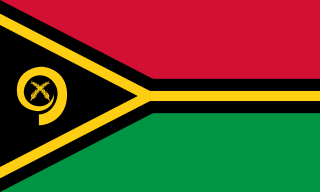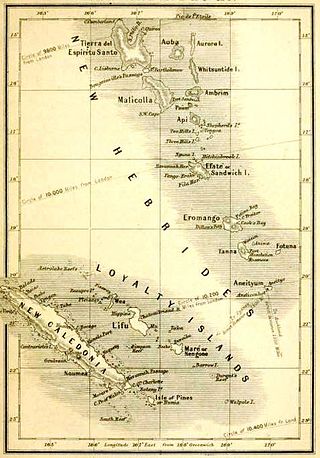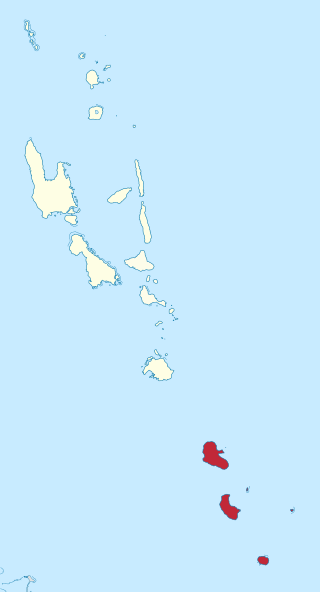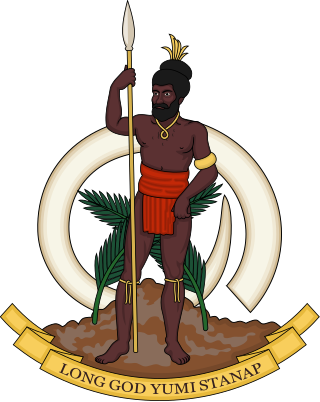
Vanuatu, officially the Republic of Vanuatu, is an island country in Melanesia, located in the South Pacific Ocean. The archipelago, which is of volcanic origin, is 1,750 km (1,090 mi) east of northern Australia, 540 km (340 mi) northeast of New Caledonia, east of New Guinea, southeast of Solomon Islands, and west of Fiji.

The history of Vanuatu spans over 3,200 years.

Tafea is the southernmost of the six provinces of Vanuatu. The name is an acronym for the five main islands that make up the province: Tanna, Aneityum, Futuna, Erromango and Aniwa.

Vanuatu has been divided into six provinces since 1994. The names in English of all provinces are derived from the initial letters of their constituent islands:

Tanna is an island in southern Vanuatu.

Hunter Island and Matthew Island are two small and uninhabited volcanic islands in the South Pacific, located 300 kilometres (190 mi) east of New Caledonia and south-east of Vanuatu archipelago. Hunter Island and Matthew Island, 70 km (43 mi) apart, are claimed by Vanuatu as part of Tafea Province, and considered by the people of Aneityum part of their custom ownership, and as of 2007 were claimed by France as part of New Caledonia.
The nine South Vanuatu languages form a family of the Southern Oceanic languages, spoken in Tafea Province of Vanuatu.
European exploration and settlement of Oceania began in the 16th century, starting with the Spanish (Castilian) landings and shipwrecks in the Mariana Islands, east of the Philippines. This was followed by the Portuguese landing and settling temporarily in some of the Caroline Islands and Papua New Guinea. Several Spanish landings in the Caroline Islands and New Guinea came after. Subsequent rivalry between European colonial powers, trade opportunities and Christian missions drove further European exploration and eventual settlement. After the 17th century Dutch landings in New Zealand and Australia, with no settlement in these lands, the British became the dominant colonial power in the region, establishing settler colonies in what would become Australia and New Zealand, both of which now have majority European-descended populations. States including New Caledonia (Caldoche), Hawaii, French Polynesia, and Norfolk Island also have considerable European populations. Europeans remain a primary ethnic group in much of Oceania, both numerically and economically.

Epi is an island in Shefa Province, Vanuatu, at the north end of the Shepherd Islands.

Erromango is the fourth largest island in the Vanuatu archipelago. With a land area of 891.9 square kilometres (344.4 sq mi), it is the largest island in Tafea Province, the southernmost of Vanuatu's six administrative regions.

Paama is a small island in Malampa Province, Vanuatu.
Anejom̃ or Aneityum is an Oceanic language spoken by 900 people on Aneityum Island, Vanuatu. It is the only indigenous language of Aneityum.

The Vanuatu white-eye or yellow-fronted white-eye is a small passerine bird belonging to the genus Zosterops in the white-eye family Zosteropidae. It is endemic to Vanuatu, where it is one of the most common birds.

Vanikoro is an island in the Santa Cruz group, located 118 kilometres to the Southeast of the main Santa Cruz group. It is part of the Temotu Province of Solomon Islands.
Araki is a small rocky island with an area of 2.5 km², located 3 miles off the southern shores of Espiritu Santo, which is the largest island in the nation of Vanuatu.

Erromangan, or Sie (Sye), is the primary language spoken on the island Erromango in the Tafea region of the Vanuatu islands. The other Erromanga languages are either moribund or extinct. Although the island is quite large (887 km2), the total number of speakers of Erromango is estimated at 1900.

John Geddie was a Scots-Canadian missionary who was known as "the father of Presbyterian missions in the South Seas." He pioneered missionary work in the New Hebrides islands, now known as Vanuatu. He became Doctor of Divinity in 1866. On December 14, 1872, he died in Geelong, Australia.

Inyeug Island is a small uninhabited island in Tafea Province of Vanuatu in the Pacific Ocean. "Inyeug" means "Small Island" in a local language. Inyueg is also called Mystery Island by the cruise ships that regularly visit the island.
















